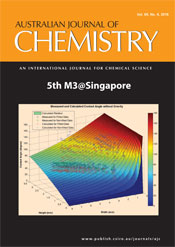
Australian Journal of Chemistry
Volume 69 Number 4 2016
RESEARCH FRONT: 5th Molecular Materials Meeting (M3) @ Singapore
CHv69n4_FOThe 5th Molecular Materials Meeting (M3) @ Singapore

This foreword introduces some selected papers presented at the 5th Molecular Materials Meeting in Singapore (M3@Singapore) from 3 to 5 August 2015 that was organized by the Institute of Materials Research and Engineering (IMRE) of A*STAR, Singapore. The conference brought together leading researchers in the disciplines of chemistry, materials science, physics, biology, medicine, and engineering to discuss advances in molecular materials and cultivate cross-disciplinary research.
CH15636Cationic Micelles Based on Polyhedral Oligomeric Silsesquioxanes for Enhanced Gene Transfection
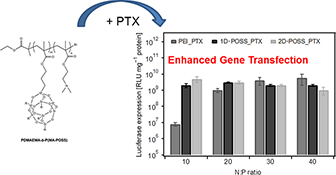
Poly(2-(dimethylamino)ethyl methacrylate)-poly(methacrylate isobutyl polyhedral oligomeric silsesquioxane) (PDMAEMA-POSS) copolymers were synthesized for co-gene and drug delivery. The hydrophobic POSS interior allows incorporation of hydrophobic drugs, and the PDMAEMA corona allows the complexation of DNA to form a nano-sized polyplex. These copolymers display excellent gene transfection efficiency when compared with PEI or PDMAEMA homopolymers.
CH15650Hybrid 1,2,3-Triazole Supported CuII Complexes: Tuning Assembly and Weak Interaction-Driven Crystal Growth

The relationship between lattice molecular structures and crystal morphology can be explained by H-bonding interactions in three functionalised triazole supported metal complexes.
CH15624Structural Basis for the Structure–Activity Behaviour of Oxaliplatin and its Enantiomeric Analogues: A Molecular Dynamics Study of Platinum-DNA Intrastrand Crosslink Adducts
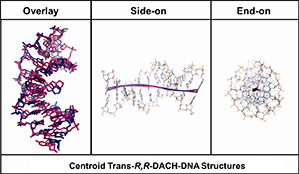
Molecular dynamics simulations of oxaliplatin enantiomeric analogues, trans-R,R-, trans-S,S-, and cis-DACH-Pt-DNA adducts, and undamaged DNA were performed to probe for stereoselectivity-based conformational differences and explain their different anti-tumour activities.
CH15659An Injectable Double-Network Hydrogel for Cell Encapsulation
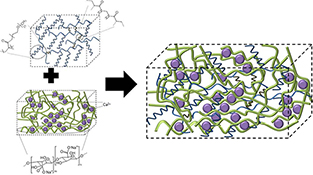
We show in this study that the double-network system can also be used to synthesize an injectable gel made up of poly(ethylene glycol) methyl ether methacrylate and sodium alginic acid. The results of a cell cytotoxicity test and preliminary cell encapsulation study showed good cell compatibility, suggesting that the hydrogels could potentially be used for cell delivery.
CH15721Enhancement of Oxidation of Formic Acid in Acid Medium on Zirconia-Supported Phosphotungstate-Decorated Noble Metal (Pd, Pt) Nanoparticles
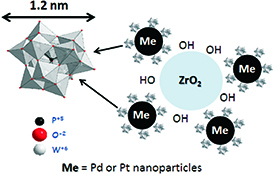
Reactive –OH groups at ZrO2 nanostructures promote dehydrogenation of HCOOH to CO2 (at Pd) and induce oxidative removal of poisoning intermediates (at Pt and Pd). Polytungstate adsorbates on Pd or Pt nanoparticles interact competitively with the poisoning CO intermediates at noble metal catalytic sites (‘third-body’ effect).
CH15738Diketopyrrolopyrrole-Based Low-Bandgap Conjugated Polymers with Siloxane Side Chains for Electrochromic Applications
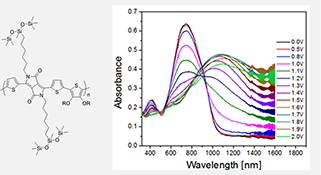
Diketopyrrolopyrrole-based conjugated polymers with siloxane side chains are synthesized and these polymers show good optical contrasts in the visible and near-infrared regions, high stability, as well as coloration efficiency of up to 408 cm2 C–1.
CH15744Polyaniline-Supported Bacterial Biofilms as Active Matrices for Platinum Nanoparticles: Enhancement of Electroreduction of Carbon Dioxide

A hybrid support composed of a polyaniline underlayer, Yersinia entrocolitica biofilm, and an overlayer of multiwalled carbon nanotubes significantly enhances the activity of platinum nanoparticles towards the reduction of carbon dioxide, rather than hydrogen evolution, in neutral medium (phosphate buffer at pH 6.1).
CH15652Efficient Synthesis of All-Aryl Phenazasilines for Optoelectronic Applications
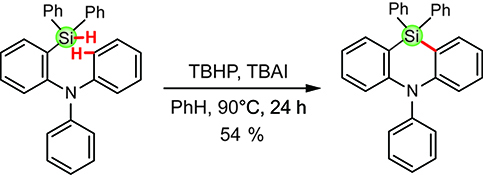
An efficient metal-free radical-catalyzed intramolecular silylation method has been developed for the preparation of all-aryl phenazasilines. The as-synthesized all-aryl phenazasiline, 5,10,10‐triphenyl‐5,10-dihydrophenazasiline, exhibits excellent solubility, high thermal stability, and good optoelectronic properties, which are highly attractive for optical and electronic applications in organic electronics.
CH15660Au-Pd Bimetallic Nanoparticle Electrodes for Direct Electroreduction of Hexavalent Chromium Complexes
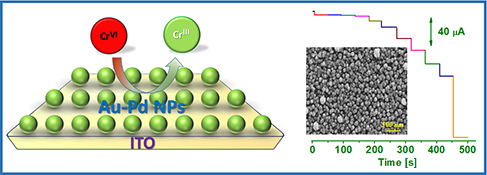
An electrochemical sensor based on a Au-Pd bimetallic nanoparticle-decorated indium tin oxide electrode was used for CrVI detection for the first time. The proposed method showed high selectivity and stability for CrVI electrodetection. The sensor was successfully applied to water samples from real world sources.
CH15730Empirical Formulae in Correlating Droplet Shape and Contact Angle
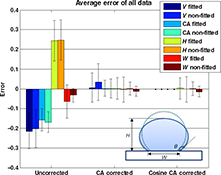
Our studies on water droplets with various volumes and contact angles show that the volume, contact angle, height, and width calculated by the spherical dome model have errors in the range of 5–25 %, whereas our empirical formulae can reduce these errors to 0.1–2 %.
CH15377Fullerene–Pyrrolidine Biferrocene Donor–Acceptor Triads: Synthesis and Effects of Fullerene[60] on the Electronic Communication of the Two Ferrocene Units in Biferrocene
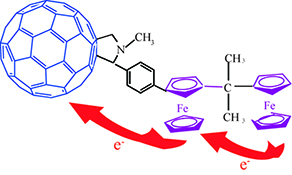
A fullerene–pyrrolidine biferrocene donor–acceptor triad was synthesized and fully characterized, and the effects of fullerene[60] on the electronic communication of the two ferrocene units in biferrocene were studied.
CH15338Three 3d–4f Tetranuclear Complexes Based on 2,3,5-Trichlorobenzoic Acid: Syntheses, Structures, and Magnetic Properties

Three 3d–4f tetranuclear complexes Co2Ln2(L)10(bipy)2 (Ln = Dy 1, Ho 2, and Er 3), where HL and bipy are 2,3,5-trichlorobenzoic and acid 2,2′-bipyridine, have been synthesized hydrothermally and characterized. The tetranuclear clusters of 1–3 construct 2D layers by weak hydrogen bonds. Magnetic studies indicate ferromagnetic interactions between adjacent metal ions in complexes 1 and 3 and antiferromagnetic interactions in 2.
CH15346Lactic Acid Determination in Human Plasma Using Ultrasound-Assisted Emulsification Microextraction Followed by Gas Chromatography
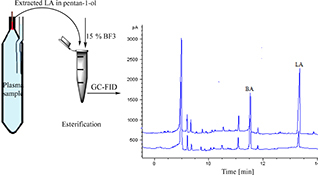
The ultrasound-assisted emulsification microextraction method followed by gas chromatography–flame ionization detection was developed for determination of lactic acid in human plasma to monitor lactic acidosis.
CH15472Thermal and Spectral Analysis of Novel Amide-Tethered Polymers from Poly(allylamine)

Using post-polymerization modification a library of amide-linked polyelectrolytes with tethered aliphatic, aromatic, and cubyl moieties were synthesized. The degree of amidation was determined by elemental analysis. The thermal (DSC/TGA) and spectral (13C SSNMR) properties of the polymers were also analyzed.
CH15402First Principle Study of Electronic and Non-Linear Optical (NLO) Properties of Triphenylamine Dyes: Interactive Design Computation of New NLO Compounds
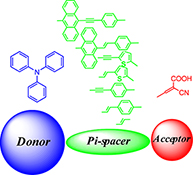
The structure–property relationship indicates that the β value increases with increasing π-conjugating lengths. Based on experimental and theoretical explorations, the design of molecules with good second-order non-linear optical properties was primarily focussed on planar D–π–A models (D = donor, A = acceptor).
CH15395Label-Free and Sensitive Detection of BRCA1 and TB4 DNA Sequences with Water-Soluble Cationic Polythiophenes
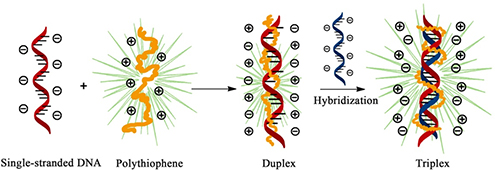
A sensitive method for BRCA1 and TB4 DNA sequences detection using water-soluble cationic polythiophenes, poly(3-(1′-ethoxy-2′-N-methyl imidazole)thiophene) (PT) is presented. The fluorescence of PT would recover to its initial intensity after the addition of complementary ssDNA, whereas sequences with mismatched bases would not.
CH15428Self-Generated Macrochannel-Structure TiO2/g-C3N4 with High Photocatalytic Activity
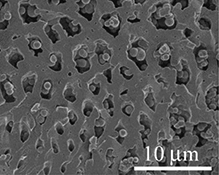
TiO2/g-C3N4 composites with macrochannel structure were successfully synthesised without using templates. The as-prepared composites show enhanced photocatalytic activity under visible light or simulated sunlight irradiation.



